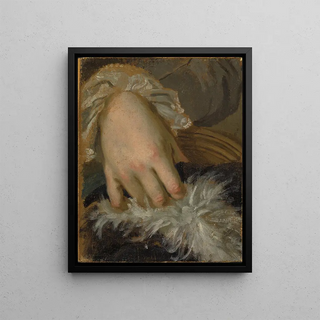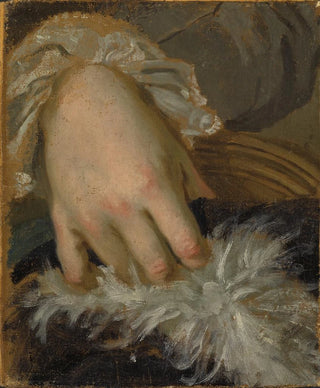Art print | Study of a hand - Lorens Pasch the Younger


View from behind

Frame (optional)
Lorens Pasch the Younger's "Study of a Hand" art print offers a captivating glimpse into 18th-century artistic mastery. This piece, both simple and intricate, transcends a mere anatomical study. It embodies a pursuit of precision and beauty, reflecting the obsession of artists of that era with the faithful depiction of the human form. The hand, often seen as a mirror of the soul, becomes a subject that goes beyond technical exercise to reach poetic dimensions. Viewing this art print invites the observer to explore the delicacy of forms, the subtlety of shadows, and the mastery of light—elements that give the hand a life of its own.
Style and uniqueness of the art print
The style of "Study of a Hand" is distinguished by its striking realism and meticulous detail. Lorens Pasch the Younger, a master of observation, captures every nuance—the veins of the skin, the play of light on the contours of the hand. This attention to detail demonstrates refined technique, inherited from the great masters of the Renaissance, while also embracing a baroque tradition that emphasizes emotion and expressiveness. The composition, though centered on a single element, reveals a subtle dynamism, where the hand appears almost alive, ready to animate. This choice of subject, far from being trivial, also invites reflection on the very nature of art and representation, raising questions about what constitutes beauty and harmony in the visual world.
The artist and his influence
Lorens Pasch the Younger, born in Sweden, was an artist whose work aligns with the Rococo movement, characterized by a quest for lightness and grace. His training with great masters and immersion in European artistic traditions shaped his unique approach. Pasch does not merely reproduce reality; he elevates it, transforming it into an aesthetic experience. His influence is evident not only in his own works but also among artists who have interacted with him or been inspired by his vision.

Matte finish

View from behind

Frame (optional)
Lorens Pasch the Younger's "Study of a Hand" art print offers a captivating glimpse into 18th-century artistic mastery. This piece, both simple and intricate, transcends a mere anatomical study. It embodies a pursuit of precision and beauty, reflecting the obsession of artists of that era with the faithful depiction of the human form. The hand, often seen as a mirror of the soul, becomes a subject that goes beyond technical exercise to reach poetic dimensions. Viewing this art print invites the observer to explore the delicacy of forms, the subtlety of shadows, and the mastery of light—elements that give the hand a life of its own.
Style and uniqueness of the art print
The style of "Study of a Hand" is distinguished by its striking realism and meticulous detail. Lorens Pasch the Younger, a master of observation, captures every nuance—the veins of the skin, the play of light on the contours of the hand. This attention to detail demonstrates refined technique, inherited from the great masters of the Renaissance, while also embracing a baroque tradition that emphasizes emotion and expressiveness. The composition, though centered on a single element, reveals a subtle dynamism, where the hand appears almost alive, ready to animate. This choice of subject, far from being trivial, also invites reflection on the very nature of art and representation, raising questions about what constitutes beauty and harmony in the visual world.
The artist and his influence
Lorens Pasch the Younger, born in Sweden, was an artist whose work aligns with the Rococo movement, characterized by a quest for lightness and grace. His training with great masters and immersion in European artistic traditions shaped his unique approach. Pasch does not merely reproduce reality; he elevates it, transforming it into an aesthetic experience. His influence is evident not only in his own works but also among artists who have interacted with him or been inspired by his vision.






